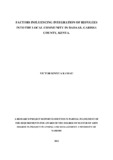| dc.description.abstract | For refugees and internally displaced persons forced to flee their homes, there are only three
durable solutions: voluntary return, resettlement and local integration. Ideally, local
integration affords refugees and IDPs opportunities to protect their fundamental rights, to
participate fully in the economic, social and cultural life of the local community and to enjoy
a basic standard of living. Those who flee persecution and conflict often lose everything.
Providing them with an opportunity to access education, employment, training and social
services, builds their capacity to return home, if conditions allow, and rebuild their
communities (Jesuit Refugee Services, 2006). In Kenya, a country that today is home to more
than 625,250 refugees according to (UNHCR, 2014), there has been significant attention on
the plight of refugees living in overcrowded camps such as Dadaab in the north east of the
country. Yet there has been little focus on the growing number of refugees living in its urban
centres. Related literature review on several factors which influence the process of integration
namely: family support systems, knowledge of local language, socio-cultural factors and
government support systems makes up part of the research. The research employed
descriptive survey design and both qualitative and quantitative survey designs with the data
collected using key-in-depth interviews and focus group discussions (FGD‘s). The
quantitative data from the study was summarized and analysed using the Statistical Package
for the Social Sciences (SPSS) where tables were generated to assist the researcher answer
the research questions. Other information derived from key informers and FGD‘s was content
analyzed using qualitative method. The main findings of the study was that a higher
percentage of refugees are those that came into the country after the enactment of the Kenya
refugee act 2006 which gave provisions for integration into local communities compared to
those who came into the country prior to that. This however has not influenced the choice of
the majority of refugees on a permanent solution to their situation as refugees since a greater
number of the refugees prefer going back to their country of origin compared to integrating
into local communities. It became apparent that there is no clear opinion on if life outside the
camps for refugees is something to pursue. This was apparent even though a sizeable number
of refugees seemed to know that of refugees who had integrated. The study established that
family support systems which include emotional support, financial support, separation and
family role, play a key role in the process of integration though emotional support did not
come out strongly as a major factor. The study established that language influences local
integration of refugees into local communities in Dadaab showing communication is a key
ingredient for any refugee seeking integration. Social-cultural factors influence local
integration of refugees into local communities in Dadaab since sharing the same beliefs as the
local community, importance of family ties, sharing the same clan, inter-marriage-ability with
the local community and sharing the same religion with the local community proved to be
key ingredients of the refugee community as well as the local community. The study
established that government support systems play the greatest role in facilitating local
integration of refugees into local communities. It was noted that the legislation that legalized
refugee integration was ambiguous and not clear enough for any refugee to follow. Even
though the refugees felt satisfied with the security the government provided at the camp level,
had their rights protected, the financial provision was insufficient to pursue integration. There
is an elaborate framework under which DRA and other NGO‘s utilize in catering for the
needs of refugees in the camps. However when it comes to the question of integration into the
local community there are bottle necks in that both the government through DRA and other
NGO‘s are lacking in policy which informs resource allocation and facilitation. | en_US |

